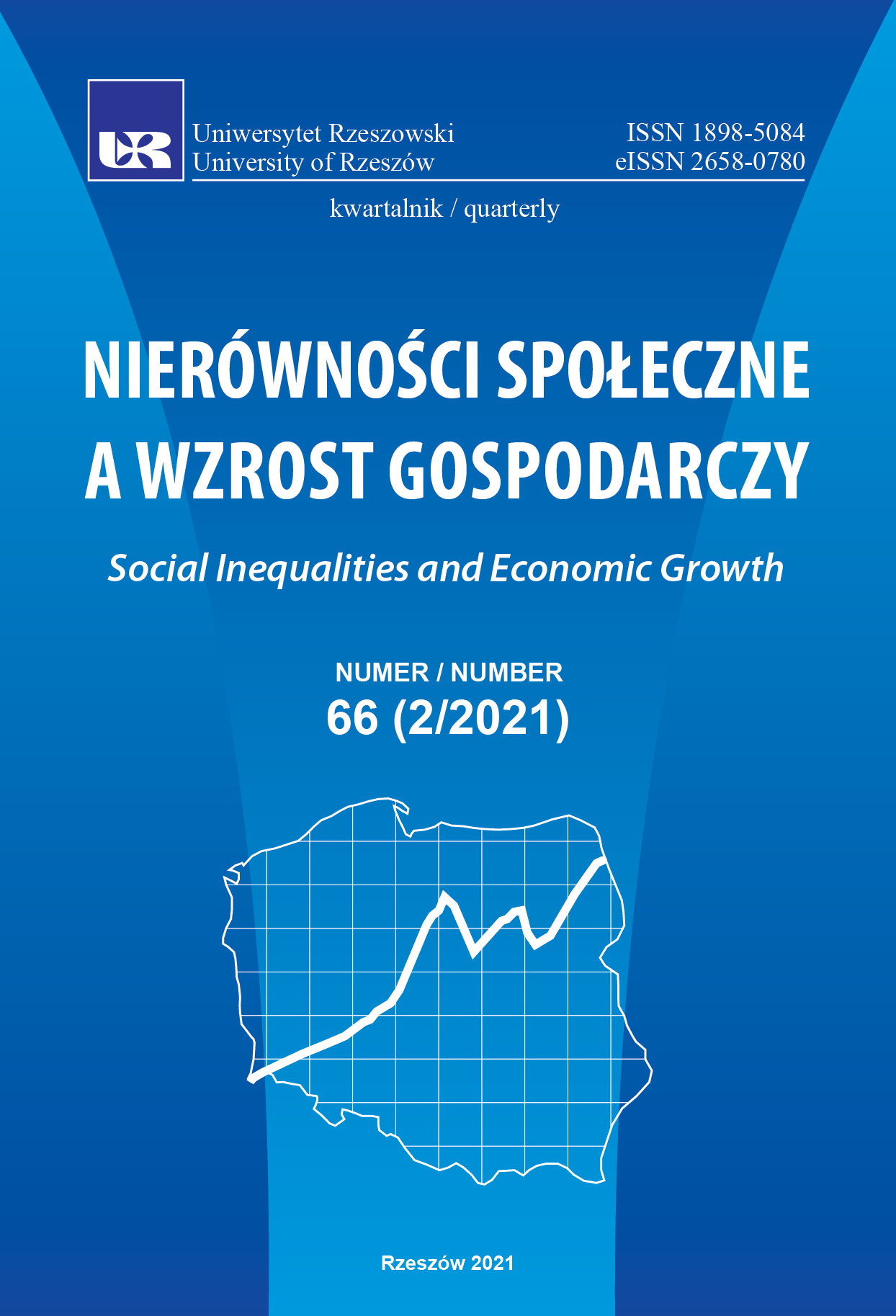Wzbogacona rzeczywistość a nierówności społeczne
DOI:
https://doi.org/10.15584/nsawg.2021.2.6Słowa kluczowe:
wzbogacona rzeczywistość, nierówności społeczne, gospodarkaAbstrakt
Artykuł dotyczy technologii wzbogaconej rzeczywistości (z ang. Extended Reality), zaś jego celem jest zwrócenie uwagi na wybrane kwestie związane z technologią i rozwiązaniami z obszaru wzbogaconej rzeczywistości w kontekście nierówności społecznych. W pierwszej części artykułu omówiono istotę technologii wzbogaconej rzeczywistości, zwracając uwagę na jej miejsce we współczesnej gospodarce wraz z opisem tego rodzaju rozwiązań. Dalsza część opracowania koncentruje się na zagadnieniu nierówności społecznych, ze szczególnym uwzględnieniem wpływu wzbogaconej rzeczywistości na problem luki i wykluczenia cyfrowego. W artykule zaprezentowano wyniki autorskich badań na grupie 88 respondentów z wykorzystaniem CAWI oraz sprzętu obsługującego technologię wzbogaconej rzeczywistości, z których 39,36% deklarowało testowanie tego
rodzaju sprzętu już w przeszłości.
Dostrzeżono, iż rozwiązania związane ze wzbogaconą rzeczywistością obecnie są nadal postrzegane jako dobra luksusowe, pomimo zwiększającej się dostępności dla użytkowników oraz niewątpliwych walorów wyjątkowości (realizm generowanych doświadczeń, zjawiska zanurzenia się w syntetycznym świecie). Analiza roli tego typu rozwiązań w kontekście nierówności społecznych, dostarcza wniosku o ich dychotomicznym charakterze. Z jednej strony można mówić, iż poprzez popularyzację tego rodzaju technologii tworzy się możliwość przekraczania barier i nierówności wynikających z cech indywidualnych czy pozycji społecznej, co w konsekwencji prowadzi do poprawy sytuacji życiowej części osób dotychczas borykających się z wykluczeniem. Spojrzenie z innej perspektywy dostarcza zaś wniosku, że tak zaawansowana technologia wchodząc do życia codziennego ma potencjał do wykreowania kolejnego podziału cyfrowego, który w długookresowej perspektywie zaowocuje narastaniem dysproporcji oraz zjawiskiem wykluczenia cyfrowego.
Downloads
Bibliografia
Bailenson, J. (2018). Experience on demand: What virtual reality is, how it works, and what it can do. New York: WW Norton & Company.
Bezegová, E., Ledgard, M. A., Molemaker, R., Oberč, B. P., Vigkos, A. (2019). Virtual reality and its potential for Europe. Pobrane z: https://ec.europa.eu/futurium/en/system/files/ged/vr_ecosystem_eu_report_0.pdf (2020.05.10).
Bonetti, F., Warnaby, G., Quinn, L. (2018). Augmented reality and virtual reality in physical and online retailing: A review, synthesis and research agenda. W: T. Jung, M.C. Dieck, Augmented Reality and Virtual Reality. Empowering Human, Place and Business (s. 119–132). Cham: Springer International Publishing. DOI: 10.1007/978- 3-319-64027-3_9.
Bourdieu, P. (2005). Dystynkcja. Społeczna krytyka władzy sądzenia. Warszawa: Wydawnictwo Naukowe Scholar.
Cebula, M. (2012). Internet a struktura społeczna – problem cyfrowego podziału. W: A. Dytman-Stasieńko, J. Stasieńko (red.), Język @ multimedia 3. Dialog – konflikt (s. 43–57). Wrocław: WN DSW.
European Commission. (2016). 100 Radical Innovation Breakthroughs for the future. Pobrane z: https://ec.europa.eu/info/sites/default/files/research_and_innovation/knowledge_publications_tools_and_data/documents/ec_rtd_radical-innovation-break¬through_052019.pdf (2020.06.11).
Farshid, M., Paschen, J., Eriksson, T., Kietzmann, J. (2018). Go boldly!: Explore augmented reality (AR), virtual reality (VR), and mixed reality (MR) for business. Business Horizons, 61(5), 657–663. DOI: 10.1016/j.bushor.2018.05.009.
Felnhofer, A. (2017). February 16). Medical University of Vienna. Social exclusion in virtual realities has a negative social and emotional impact in ‘real’ life. Science Daily. Pobrane z: www.sciencedaily.com/releases/2017/02/170216105520.htm (2021.04.20).
Feltham, J. (2021). One VR Studio Is Using Quest To Highlight Discrimination And Exclusion At Work. Pobrane z: https://uploadvr.com/quest-app-discrimination-work/ (2021.04.21).
Greenleaf, W. (2019). How Virtual Reality Technology Will Impact Healthcare. Pobrane z: https://www.slideshare.net/waltergreenleaf/virtual-reality-and-healthcare-the-past-the-present-and-the-future (2020.05.17).
Greenwald, W. (2020). The Best VR Headsets for 2020. Pobrane z: https://www.pcmag. com/picks/the-best-vr-headsets (2020.06.24).
Kallmann, M., Camporesi, C., Han, J. (2015). Vr-assisted physical rehabilitation: Adapting to the needs of therapists and patients. W: G. Brunnett, S. Coquillart, R. van Liere, G. Welch, L. Váša (red.), Virtual Realities. Lecture Notes in Computer Science, vol. 8844 (s. 147–168). Springer, Cham. DOI: 10.1007/978-3-319-17043-5_9.
Kasprzyk, B. (2014). Nierówności ekonomiczne: ich postrzeganie i skala akceptacji społecznej. Studia Ekonomiczne, 180, 110–120.
Lang, B. (2020). WalkinVR Add-on Makes VR More Accessible to Disabled. Pobrane z: https://www.roadtovr.com/walkinvr-steam-launch-vr-disabled-accessibility/ (2021.04.25).
Nieradka, P. (2019). Using virtual reality technologies in the real estate sector. Annales Universitatis Mariae Curie-Skłodowska, Sectio H Oeconomia, 53(2), 45–53. DOI: 10.17951/h.2019.53.2.45-53.
O'Donnell, D. (2018). Driving immersive experiences in virtual and augmented reality. Pobrane z: https://blog.westerndigital.com/driving-immersive-experience-virtual-augmentedreality/ (2020.05.25).
Pardel, P. (2009). Przegląd ważniejszych zagadnień rozszerzonej rzeczywistości. Studia Informatica, 30(1), 82, 35–64.
Prendergast, C. N., Schubert, T. (2020). Investigating Reflexive Responses to Explicit and Implicit Forms of Social Exclusion Using Immersive Virtual Environment Technology. Frontiers in Psychology, 11, 566212. DOI: 10.3389%2Ffpsyg.2020.575783.
Prieur, A., Savage, M. (2011). Updating cultural capital theory: A discussion based on studies in Denmark and in Britain. Poetics, 39(6), 566–580. DOI: 10.1016/j.poetic.2011.09.002.
Rauschnabel, P. A., Rossmann, A., tom Dieck, M. C. (2017). An adoption framework for mobile augmented reality games: The case of Pokémon Go. Computers in Human Behavior, 76, 276–286. DOI: 10.1016/j.chb.2017.07.030.
Rubin, R. (2020). Vendors face the tough reality of affordable VR. Pobrane z: https://www. zdnet.com/article/vendors-face-the-tough-reality-of-affordable-vr/ (2020.07.24).
Suh, A., Prophet, J. (2018). The state of immersive technology research: A literature analysis. Computers in Human Behavior, 86, 77–90. DOI: 10.1016/j.chb.2018.04.019.
Sveistrup, H. (2004). Motor rehabilitation using virtual reality. Journal of neuroengineering and rehabilitation, 1(1), 1–8. DOI: 10.1186/1743-0003-1-10.
Tepper, O. M., Rudy, H. L., Lefkowitz, A., Weimer, K. A., Marks, S. M., Stern, C. S., Garfein, E. S. (2017). Mixed reality with HoloLens: where virtual reality meets augmented reality in the operating room. Plastic and Reconstructive Surgery, 140(5), 1066–1070. DOI: 10.1097/PRS.0000000000003802.
tom Dieck, M. C., Jung, T. (2018). A theoretical model of mobile augmented reality ac¬ceptance in urban heritage tourism. Current Issues in Tourism, 21(2), 154–174. DOI: 10.1108/IJCHM-02-2017-0084.
Virvou, M., Katsionis, G. (2008). On the usability and likeability of virtual reality games for education: The case of VR-ENGAGE. Computers & Education, 50(1), 154–178. DOI: 10.1016/j.compedu.2006.04.004.
Wójcik-Żołądek, M. (2013). Nierówności społeczne w Polsce. Infos Zagadnienia Społeczno-Gospodarcze, 20, 1–4.
Zillien, N., Hargittai, E. (2009). Digital distinction: Status‐specific types of internet usage. Social Science Quarterly, 90(2), 274–291. DOI: 10.1111/j.1540-6237.2009.00617.x.
Pobrania
Opublikowane
Jak cytować
Numer
Dział
Licencja

Utwór dostępny jest na licencji Creative Commons Uznanie autorstwa – Na tych samych warunkach 4.0 Miedzynarodowe.


